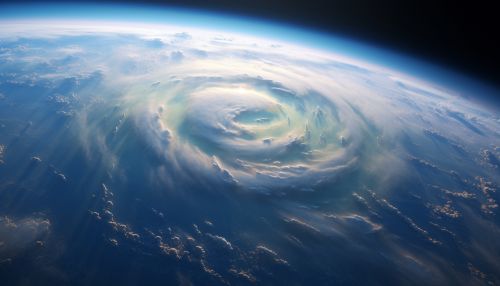Tropical Cyclone Formation and Dynamics
Introduction
A tropical cyclone is a rapidly rotating storm system characterized by a low-pressure center, a closed low-level atmospheric circulation, strong winds, and a spiral arrangement of thunderstorms that produce heavy rain or squalls. Depending on its location and strength, a tropical cyclone is referred to by different names, including hurricane, typhoon, tropical storm, cyclonic storm, tropical depression, and simply cyclone.
Formation
Tropical cyclones form over large bodies of warm water and derive their energy through the evaporation of water from the ocean surface, which ultimately recondenses into clouds and rain when moist air rises and cools to saturation. This energy source differs from that of mid-latitude cyclonic storms, such as nor'easters and European windstorms, which are fueled primarily by horizontal temperature contrasts.
Conditions for Formation
The formation of tropical cyclones is the topic of extensive ongoing research and is still not fully understood. While six factors appear to be generally necessary, tropical cyclones may occasionally form without meeting all of the following conditions.
1. Warm sea surface temperatures. These typically need to be near or above 26.5 °C (79.7 °F), and be present to a depth of at least 50 metres (160 ft). 2. Rapid cooling with height. This allows the release of the heat of condensation that powers a tropical cyclone. 3. High humidity in the lower to middle levels of the troposphere. When there is a great deal of moisture in the atmosphere, conditions are more favorable for disturbances to develop. 4. Low amounts of wind shear. Wind shear is the change in wind speed and direction with height. A large difference in wind speed and direction between the surface and the upper levels of the atmosphere can disrupt the development of a tropical cyclone. 5. A pre-existing near-surface disturbance. Tropical cyclones cannot be generated spontaneously. They require a weakly organized system with sizable spin and low-level vorticity. 6. Coriolis force. The Coriolis force is needed to create the spin in the cyclone. In the Earth's atmosphere, this is a result of the rotation of the Earth.
Dynamics
The dynamics of a tropical cyclone involves many complex interactions between the storm and its environment. These interactions include the transfer of heat and moisture, the generation of turbulence, and the development of organized convection.
Structure
Tropical cyclones are characterized by a number of distinct structural features. The central dense overcast (CDO) is the area of highest cloud tops surrounding the center of the storm. This region is typically associated with the most intense rainfall and strongest winds. Surrounding the CDO is the eyewall, a ring of towering thunderstorms where the most severe weather and highest winds occur. The eye is a region of mostly calm weather at the center of the eyewall.
Movement
The movement of a tropical cyclone (i.e., its "track") is typically approximated as the sum of the steering flow (the non-cyclonic winds blowing around the cyclone) and a beta drift (a small, systematic motion to the north and west caused by the rotation of the Earth).
Intensity
The intensity of a tropical cyclone is determined by the maximum sustained wind speed. The Saffir-Simpson scale categorizes hurricanes into five categories based on their wind speed, central pressure, and damage potential.
See Also


